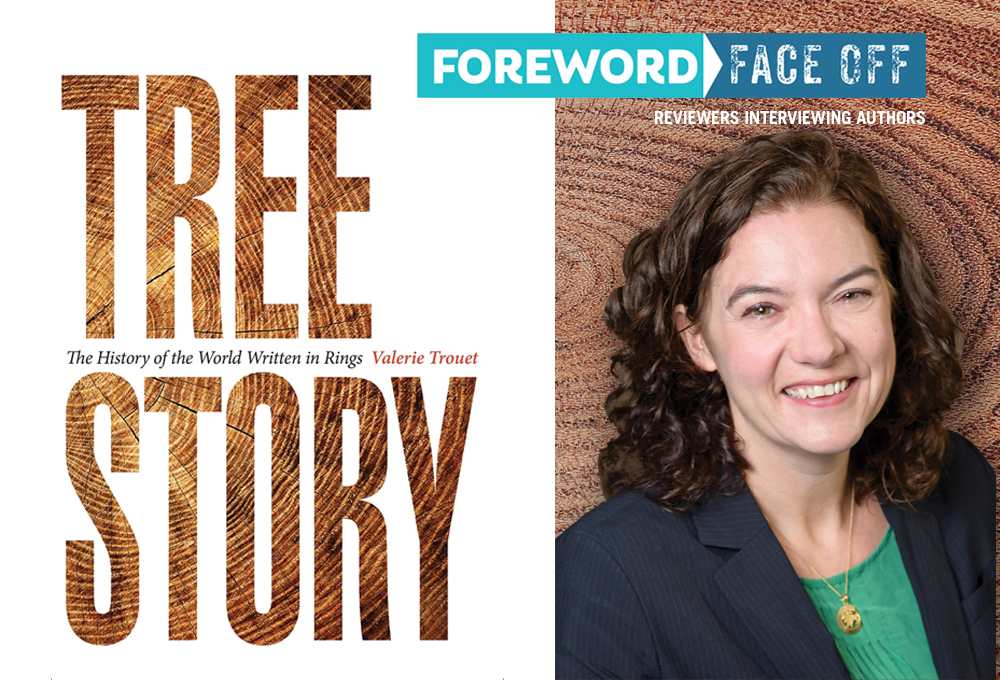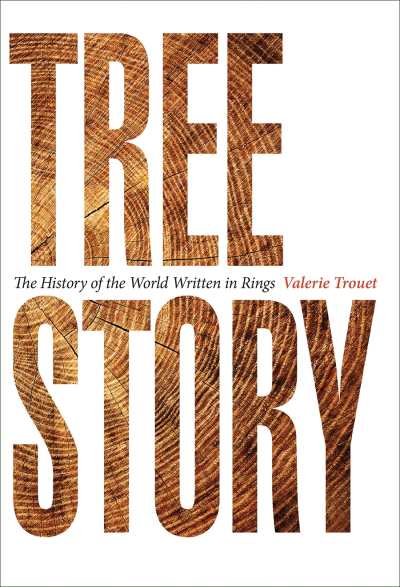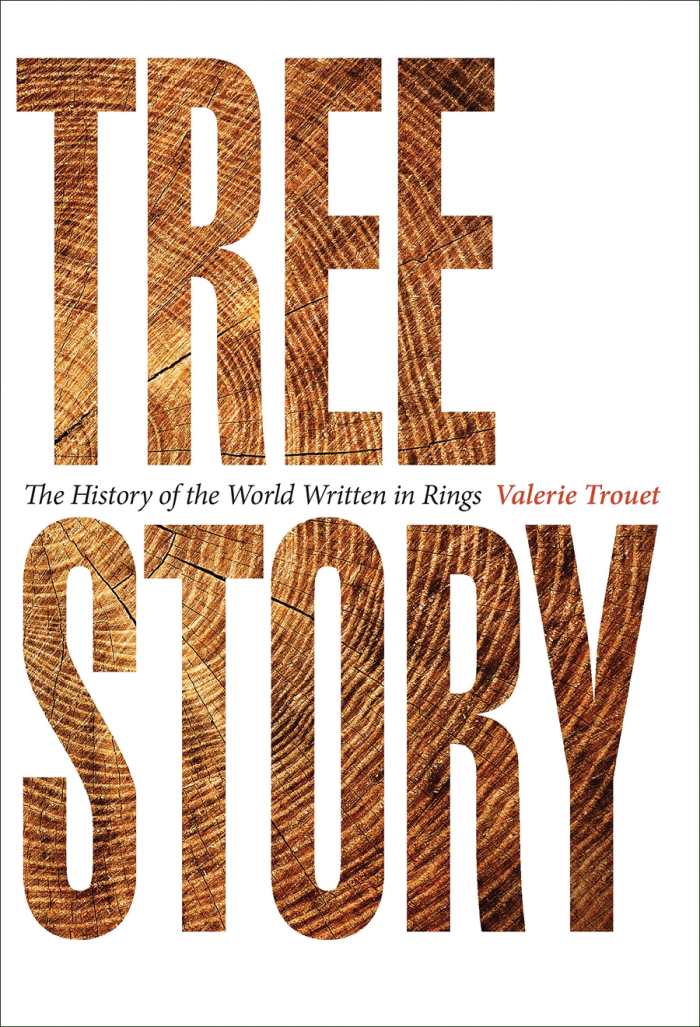Meet the Scientist Author of Tree Story: The History of the World Written in Rings

Humans too often view the earth and its plant and animal inhabitants with rapacious eyes, a what-can-you-do-for-me attitude that has laid waste to minerals, fossil fuels, water sources, and anything living that might be eaten, smoked, worn, or used to build something. That’s just the nature of our species. It’s all about us. When it comes to the planet, we persistently miss the forest for the trees.
For more than 350 million years, those forests and trees have evolved to play an extraordinary role for Mother Nature. Just one good size tree, of the three trillion on earth, supplies a day’s worth of oxygen for four people. And let’s not forget—in this warming era—that that same tree will suck nearly fifty pounds of carbon from the atmosphere in a year. So, yeah, go outside right now and hug the first trunk you see.

This week’s guest is Valerie Trouet, a tree expert from the inside out. As a dendrochronologist, she studies the annual rings every tree produces, but not just to learn how old an individual tree is. By closely studying ancient samples from tree rings around the world, Valerie and her colleagues can look back an astounding 12,650 years, and gain insight into everything from climate change to California wildfires to how volcanoes affected Egypt’s pharaohs.
Valerie’s new book, Tree Story: The History of the World Written in Rings, takes readers into the forests and labs of her working life and further helps us realize how lucky we are to share a planet with such amazing life forms.
Matt Sutherland penned the review of Tree Story for the July/August issue of Foreword, and we recently reached out Johns Hopkins University Press to line up this FaceOff conversation.
Matt, you’re up.
Can you talk a bit about dendrochronology history? When did we first start realizing tree rings have so much more to offer than simply denoting a tree’s age?
Dendrochronology as a field of science started in the early twentieth century. Andrew Ellicott Douglass, an astronomer at the University of Arizona in Tucson, came up with the idea to study the rings in long-lived trees to see if they could provide information about the solar cycles (cyclicity in the energy coming from the sun) that he was interested in. In doing so, Douglass discovered that trees capture past climate conditions in their rings and can thus be used to study the climate of the past. By collaborating with southwestern archeologists, he also discovered that the rings found in archeological wood can be used to date archeological sites. In 1937, after developing the field of dendrochronology for about three decades, he established the Laboratory of Tree-Ring Research at the University of Arizona.
If I understand correctly, the main tool of your trade is an increment borer, which you drill into the center of a tree and extract a long thin wooden dowel-shaped sample showing all the annual rings in a tree’s life. How else do you do your work? What other tools do you use?
Yes, we use an increment borer to sample living trees without killing or harming them and to sample archeological wood without leaving much of a mark. For dead trees and subfossil wood (that has been preserved in lakes and bogs) we often use a chainsaw. To look at the rings and date art historical pieces, such as paintings on wood panels or musical instruments, we often work on high-resolution photographs or 3D scans.
After bringing the (core and chainsaw) samples back to the lab, we sand them with progressively fine sand paper and then study them under a microscope. This allows us to clearly see the boundaries between the rings and to measure ring width with great precision. For these ring-width measurements, we use a digital measurement stage connected to a computer. In addition to the width of the rings, we can also measure other characteristics of the wood in each ring, such as the wood density or its chemistry, and for this we use more advanced equipment (e.g., a densitometer or a mass spectrometer).
Please explain what a narrow ring and wide ring denote in the life of a tree? And, what are the different factors that can affect a tree’s rings, from year to year?
The year-to-year variability in the width of tree rings is determined by many factors, the main ones being the climate (amount of rain, temperature) and other environmental factors (such as insect outbreaks and wildfire), the diameter of the tree, and competition from neighboring trees. By careful site and tree selection (e.g, an open-grown stand, a tree without fire scars), the influence of some of these factors (e.g., competition, wildfire) can be minimized, leaving climate variability as the main influence on year-to-year ring width.
Which climatic factor—precipitation or temperature—has the most influence on tree rings, depends on the climate in which a tree grows. In dry regions, such as the American Southwest, a tree’s growth depends largely on how much water is available to the tree and thus on precipitation. A tree in Arizona, for instance, will grow a lot and form a wide ring in a wet year and will grow only a little and form a narrow ring in a dry year. In cold regions, such as Alaska or the European Alps, however, tree growth is more determined by temperature than by precipitation. Alaskan trees will thus form wide rings in years with warm summers and narrow rings in years with cold summers.
By using ancient wood samples, some of which were found underwater and petrified in deserts, and then comparing tree ring patterns from older and older trees, you and your dendrochronologist colleagues have built a historical record of tree rings dating back an astounding 12,000 years or more. The sheer labor of making all those comparisons sounds exhausting. Can you give us a sense of just how incredible this scientific achievement really is? And then, maybe an example or two of certain, extraordinary finds that filled gaps in the record?
Yes! The German oak-and-pine chronology stretches back continuously from the present to 10,644 BCE. The chronology includes 6775 samples from living trees, dead trees, historical buildings, archeological sites, and peat bogs and river beds and has a ring for each and every year of the past 12,650 years. It took multiple decades of tree-ring sampling, counting, and dating to develop this long chronology, but it was worth it. The chronology has for instance been used to calibrate and validate less precise dating methods than dendrochronology, such as radiocarbon dating. What is also very cool about the German chronology, is that it corresponds year-for-year with a similar chronology from the British Isles over the more than 8,000 years over which they overlap.
The oldest portion of the chronology is based on Scots pine trunks that were found in gravel pits in Germany. The tree trunks are remnants of forests that once grew along large, German rivers (the Rhine, the Danube) but over time were undercut by erosion. The trees toppled over in the water and were preserved underwater for ten thousand years. More recent portions of the chronology are derived from water wells (where wood was also preserved under water) from Roman and Bronze Age times. My colleague Willy Tegel, for instance, found four water wells in eastern Germany that were lined with wood walls and that dated back to 5,206 BCE, not long after the first farmers immigrated into central Europe from the Balkans around 5500 BCE. Willy described this find as “The first farmers were also the first carpenters.”
What can trees and tree rings from many centuries ago teach us about climate change?
Because the growth of trees is influenced by the climate, past climate is recorded in tree rings and we can use those tree rings to understand how the climate has changed over the past centuries and even millennia. This is important, because it allows us to study natural climate variability. Measurements of weather and climate at meteorological stations on a global scale only started roughly at the beginning of the twentieth century. By this time, the Industrial Revolution was well on its way and with it ever increasing greenhouse gas emissions and an enhanced greenhouse gas effect. As a result, meteorological measurements only record climatic variability under strong anthropogenic influence. If we want to study natural climate variability, without (or only limited) anthropogenic effects, we need to go further back in time, for instance by using tree rings.
We can use many climate proxies to study the climate of the past, such as tree rings, ice cores, stalagmites. Tree rings have an advantage over other proxies in that they can be reliably dated at high time resolution—one ring is formed each and every year—and are widely available across the globe. Compared to other proxies, such as ice cores, however, tree-ring-based climate reconstructions are relatively short, covering the past centuries to millennia, rather than 10,000s to millions of years. Tree-ring based climate reconstructions tell us about the natural influences on past climate variability, such as large volcanic eruptions and changes in solar radiation. They also allow us to study the influence of past climate variability on human society and civilizations, such as the Roman Empire and the Mayan civilization.
With the atmosphere filled with more carbon than ever, are trees growing faster? Is the wood quality the same? Will all that carbon affect their longevity?
The effect of rising atmospheric carbon dioxide concentrations on tree and forest growth is a very active field of research and we don’t have a definite answer yet, because it is a complex issue. In general, trees capture carbon dioxide out of the atmosphere through photosynthesis and use it to grow wood and leaves. However, they also need water and other nutrients, such as nitrogen and phosphorus to grow. So if only carbon dioxide levels increase, but water and nutrient levels don’t, then the trees will not grow more or faster.
We can plant more trees to capture more carbon dioxide out of the atmosphere and thus help contribute to mitigating anthropogenic climate change, but also tree planting (or afforestation) is more complex than it might look at first hand. More important than planting trees, is keeping them alive, because trees only capture and store carbon dioxide as long as they are alive. As soon as a tree dies and decomposes, all the captured carbon is emitted back into the atmosphere.
Tree planting therefore needs to include considerations about tree longevity: Do we plant fast-growing tree species that capture a lot of carbon fast, but that typically do not live long? Or do we plant slow-growing species that may live much longer? In the same vein, it is worth considering wood quality when planting trees. By using wood for long-term construction purposes, such as in buildings and furniture, we can avoid the carbon stored in the stems of trees to be emitted back into the atmosphere. However, not all wood is of equal quality and useful for construction purposes. Typically, the fastest-growing, short-lived tree species, such as poplar, have light wood that is not very durable and not very useful for construction. These are just some examples of the considerations that need to be taken into account in tree planting for climate change mitigation purposes.
Recent research shows trees of the same species communicate and support each other via their shared root systems and fungi networks in the soil, in addition to chemical signals through the air. All of which hints at a much higher level of intelligence than trees are usually credited with. So, as a tree expert, what’s your take on tree intelligence? Do you believe trees are sentient beings? Could they possibly be conscious in some manner?
Rather than trees, I believe in the intelligence of forests. Trees and forests have been around on the planet for much longer than us humans and they have evolved to be well-oiled and complex organisms and ecosystems. Whereas I don’t believe that individual trees are conscious or sentient, research indeed shows that trees benefit from support from and communication with neighboring trees. As such, forests have evolved to become ecosystems of such intricate complexity that it resembles intelligence and that it benefits not only the trees, but also other plants, animals, humans, the soil, and even the forest atmosphere.
Tree Story
The History of the World Written in Rings

Valerie Trouet
Johns Hopkins University Press
Hardcover $27.00 (256pp)
978-1-4214-3777-4
Buy: Local Bookstore (Bookshop)
Oh, the things we know by the way trees grow: about the planet’s climate over the past couple thousand years, about population fluctuation from ancient Rome forward, about solar radiation variations, atmospheric pressure systems, volcanic eruptions, wildfires, hurricanes and other extreme weather events, floods, droughts, and greenhouse gas emissions. Trees, we learn, have near perfect memories.
To tap the great trove of tree knowledge, we have dendrochronoglogists, the scientists who study tree rings. Short of what has survived in written form over the centuries, dendrochronologists have filled in numerous gaps to help historians and archaeologists solve vexing questions about war and conquest, epidemics and migrations, human greed and carelessness.
In her delightful Tree Story, dendrochronologist Valerie Trouet obliterates the layman’s notion that tree rings provide little more information than a tree’s age. Examples abound. She cites Mongolian tree ring research into the period between 1211 and 1225, showing that Genghis Khan went on his roll during the wettest decades of the past eleven hundred years, providing his cavalry’s horses expansive grasslands to feed on. She and a colleague sought to explain a dramatic dip in Caribbean shipwrecks between 1645 and 1715 and realized, through tree rings in the Florida Keys, that record low sunspot numbers related to cooler waters and, thus, far fewer hurricanes during that period. What trees can teach seems limited only by science’s ability to extract the information.
MATT SUTHERLAND (May 29, 2020)
Matt Sutherland
